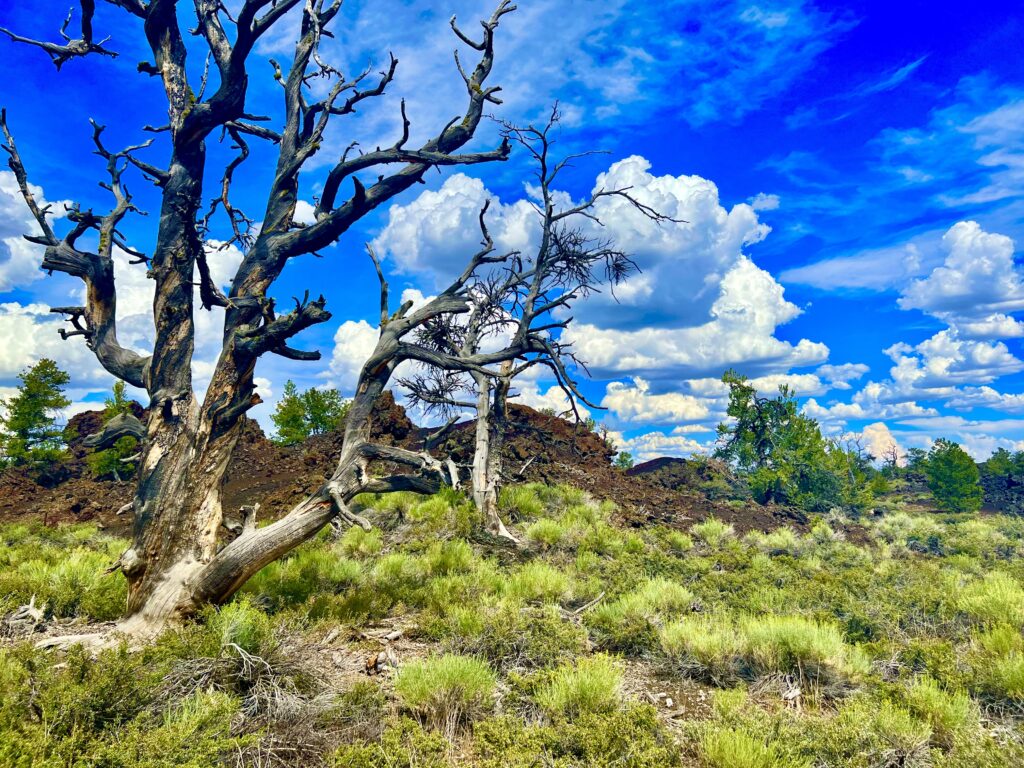Craters of the Moon National Monument is one of Idaho’s most unique landscapes. A strange and mysterious land, that can truly be described as otherworldly. Located in southern Idaho, on the Snake River Plain, Craters of the Moon preserves what was once a volcanic wonderland. Within the park’s 752,000 acres are craters, caves, cinder cones, spatter cones, and miles of lava fields. An inland sea of jagged black lava rocks, remnants of Idaho’s not so distant volcanic past.

Beginning 15,000 years ago, southern Idaho was a hotbed of volcanic activity. Craters of the Moon is the result of many different volcanic eruptions, with the most recent occurring only 2,000 years ago. At first glance, Craters of the Moon appears like a barren wasteland, but its strange beauty gradually reveals itself. Take a walk through the Devil’s Orchard, and it’s impossible not to marvel at nature’s resilience. How life can thrive in this land is beyond me, but over 800 types of plants and 300 animal species call Craters of the Moon home. In addition to being oddly scenic, Craters of the Moon has played host to some interesting history.

Historically the Oregon Trail crossed through southern Idaho, following the path of the Snake River. But by the early 1860’s, conflicts with the Native Americans led to increased interest in an alternate route. That route would be called Goodale’s Cutoff, and it crossed through what is today Craters of the Moon. By 1863, seven out of every ten wagons on the Oregon Trail took Goodale’s Cutoff, bypassing the main trail along the Snake River. Given the already difficult circumstances facing pioneers on the Oregon Trail, the sight of endless fields of black lava couldn’t have been a welcome surprise, but avoiding hostile Indians made the detour worth it.
“It was a desolate, dismal scenery. Up or down the valley as far as the eye could reach or across the mountains and into the dim distance the same unvarying mass of black rock. Not a shrub, bird nor insect seemed to live near it. Great must have been the relief of the volcano, powerful the emetic, that poured such a mass of black vomit.”
-Julius Caesar Merrill, a pioneer traveling Goodale’s Cutoff
https://www.nps.gov/crmo/learn/historyculture/goodales-cutoff.htm

Roughly 100 years after Goodale’s Cutoff was established, Craters of the Moon played host to modern day pioneers. In 1969, NASA used Craters of the Moon as a training ground for the Apollo 14 astronauts. Astronauts Alan Shepard, Edgar Mitchell, Joe Engle, and Eugene Cernan all spent time exploring Craters of the Moon, learning the basics of volcanic geology, and preparing for future lunar landings. An interesting historical addition to an already fascinating landscape.
https://www.nps.gov/crmo/learn/historyculture/astronauts.htm


Visiting Craters of the Moon
For anyone interested in making a trip to Craters of the Moon National Monument, the good news is it’s super easy to navigate once you’re there. The park is very nicely laid out, and requires minimal advanced planning. A drive along the 7 mile Loop Road, will take you past all the major attractions. Whether you want to go for a short hike, explore caves, or ascend a cinder cone, the Loop Road has you covered. There’s plenty to see within the borders of Craters of the Moon, but you really only need one day to see everything.
Located just an hour from I-15, Craters of the Moon is an interesting detour for anyone taking a road trip to Yellowstone or Grand Teton National Park. For residents of southern Idaho, it’s a 3 hour trip from Boise and 1.5 hours from Twin Falls, easily doable for a day trip. Many will never get to see this volcanic landscape, but if you ever get the opportunity, a trip to Craters of the Moon is well worth it.



“Hotbed of volcanic activity” … pun intended?
“Hotbed of volcanic activity” … pun intended?
Happy accident.